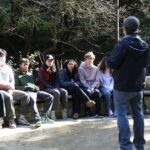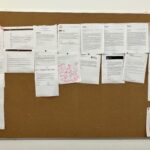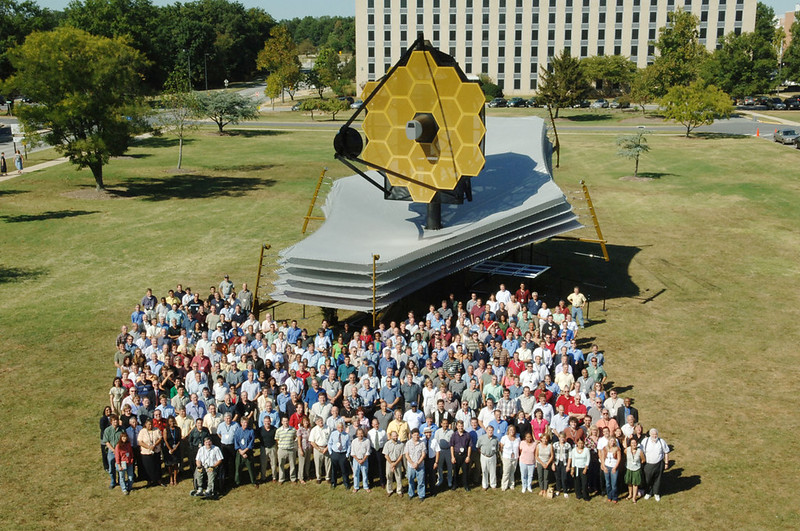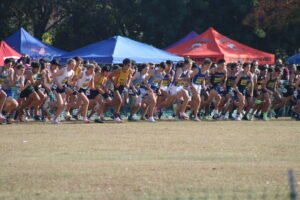Ender’s Game. Interstellar. Dune. All of these masterful works of science fiction envision a universe where humanity has taken to a new frontier and explores strange worlds. This is what the James Webb Space Telescope (JWST) is working towards.
Those alive in the 1960s recount tales of the Space Race with great pride. Since then, NASA has long faded from the spotlight of the American people’s minds. But, NASA’s star project decades in the making, the JWST, could change that.
In December, JWST will launch and perform high-tech origami, unfolding its giant golden mirrors, and in turn unfold the secrets of the young universe.
Armed with 18 hexagonal gold-coated segments, the JWST’s primary mirror is over six times larger in area and over 100 times more powerful than the Hubble Space Telescope.
The Hubble telescope is named after American astronomer Edwin Hubble, who famously petitioned the Nobel Committee to include astrophysics in the physics award. Hubble helped better estimate the age and rate of expansion of the universe, captured iconic images of nebulas and expanded the fields of astrophysics.
JWST will be able to see the light shining from the first stars in the universe. Unlike Hubble, it can see well into the infrared, which will let it peer into the dust-enshrouded centers of dark dust clouds, where stars are born and complex molecules are formed.
Also, the JWST and the Hubble’s orbiting points differ. Hubble orbits just over 350 miles above the Earth and the JWST orbits at over 930,000 miles at the second Lagrange point (L2 point). Being so far out allows the telescope to maximize cold temperatures in order to detect distant and dim objects, and prevent interruption by the Earth, unlike what Hubble has to deal with in Low Earth orbit.
The JWST is so sensitive that it could detect the heat imprint of a bee at the distance from Earth to the moon and can decipher details the size of a penny nearly 25 miles away. Also, the telescope is very big — approximately 2.5 house stories in diameter, with a sun shield the size of a tennis court. So big, in fact, that it has to be folded to fit inside its rocket ship.
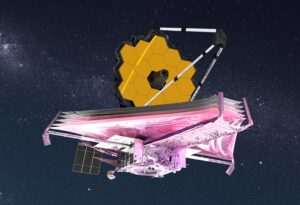
photo courtesy of NASA
Dr. Susan Neff is a Deputy Project Scientist for Operations on the telescope. Neff earned her BA degree in physics from Vanderbilt and her Ph.D. from the University of Virginia. Neff’s postdoc work in the Netherlands focused on the study of active galaxies. She used one of the early radio telescopes, the Dwingeloo radio telescope and helped connect non-experts to open the European Very Long Baseline Interferometry Network (VLBI). VLBI uses smaller separated radio telescopes to capture the universe in better detail, but also track continental drift.
Now with the JWST, Neff is applying both parts of her postdoc work: groundbreaking research and building infrastructure to connect people to that groundbreaking research.
Neff joined the JWST team in 2019 and works on “how the telescope will operate and how we will actually use it on a day to day basis.” Also, Neff and her team is helping to establish the process for “how astronomers all over the world can propose to use the telescope.”
On past projects, Neff has been the only project scientist, but Webb’s intricate design and lack of margin for error requires eleven project scientists all with different responsibilities and more than any NASA mission to ensure it launches and operates properly. The sheer size of the team requires Neff to “figure out her role” and “trust the other members.”
Over the pandemic, Neff has spent a lot of time on Zoom calls as the team is scattered between different agencies: Canadian Space Agency and European Space Agency and groups in different locations: Goddard in Greenbelt, Space Telescope Science Institute Baltimore, Northrop Grumman in Los Angeles, Ball Aerospace in Boulder and NASA HQ Washington D.C.
Though the pandemic did cause delay, Neff mentions how it was very helpful as it allowed more “rehearsals,” where they would practice everything, including the mirrors, launch and deployment. Neff, who enjoys amateur theatre, likens it to production: “It’s the same idea. as a theatrical production, right? You’re practicing and screwing up so that you do it and get it out of your system and learn how to deal with it before.”
The launch and operation of JWST has Neff excited for three things: looking at the earliest galaxies, searching and assessing exoplanets and studying galaxy feedback.
Earliest galaxies
Neff said, “We have a time machine with JWST! Because we’re looking at things so far away, it takes the light a long time to get to us. We can see the galaxies and see how they turn, which we expect to look very different.”
The second thing Neff is excited for is “looking for exoplanets which are planets around other stars — actually, more than looking for them, but trying to determine what their atmosphere is like and whether there’s water in the atmosphere. Water would indicate there’s a possibility that the planet might be habitable. That doesn’t mean that there is life there, but it means the kind of life we have on Earth could possibly have formed..”
Neff pointed out that people have already been working to find exoplanets around other stars. “I just think that’s fantastic. I have learned what I can about it, but I don’t work in that field. And there are some very complicated techniques.”
Galaxy feedback

photo courtesy of NASA
The third thing Neff is excited about is a developing field called, “Galaxy feedback.” Neff describes the limited knowledge scientists have. “We know in galaxies all the way through the history of the universe since the very earliest ones, that material flows out of galaxies and material falls into galaxies. Material falling into galaxies can feed a supermassive black hole at the center, and it can provide gas for new stars to form. We also see stuff flowing out of galaxies and energizing the areas around them. We have observed that this happens, but nobody really understands how the whole process, how the system works. We will be getting data from JWST both about the outflows and inflows that I think will help us understand that process a lot better.”
The telescope’s planning and construction have taken over 25 years since it was granted $500 million, enduring cancellation threats, political controversy and many delays. JWST has been over budget and behind schedule for years — something the U.S. government has taken note of. As a result, proposals for cuts and suggestions of axing the project entirely have been discussed, citing mismanagement and bad budgeting.
A byproduct of both NASA’s bureaucracy and increased innovation in the privatization of space travel is that some of JWST’s tech is not as innovative as it was a decade ago. Including technology of the science payload (the rocket) JWST will use to launch from as NASA opted early on the project for the reliable Ariane 5 ECA which allowed the ESA to participate in the project, rather than the newer SpaceX rockets which NASA recently used to send astronauts to the International Space Station.
On the topic of privatization of space, Neff said, “I think there’s definitely a role for privatization of space. And I think there’s also a role for the kind of thing NASA does. This is expensive, and it’s dangerous, and it doesn’t directly solve some of the problems that we have on this earth on Earth.”
Costs overrun and setbacks are nothing new for projects of unprecedented scale. The launch of the Hubble Space Telescope was famously delayed by seven years, tripling its cost by the time it reached orbit (and then it had to be modified to achieve its goals).
However, rather than focusing on a long-awaited triumph, recently, NASA has been caught up with concerns around the telescope being named after the second NASA administrator James Webb — who led the Apollo missions, but also was complicit in discrimination against LGBTQ+ employees in the 1950s and 1960s.
NASA chose not to rename its $10 billion dollar technological marvel, officially claiming that they had “found no evidence at this time that warrants changing the name of the James Webb Space Telescope.”
A bright star
On a personal level Neff is proud of the JWST team, “this large group of people with all kinds of differences and diverse reasons for even being on a project come together and they make something good happen. And it’s fantastic to be part of that. It’s like a really good, really close family. That’s not to say, we don’t have arguments. But it shows what people can do if they work together.”
If you want to see the December 22 launch of the JWST you can watch it on nasa.gov/live at 4am PST. NASA will not host in-person crowds because the launch will take place from the European Spaceport located in the South American country of French Guiana.
Also, if you are interested in learning about other telescopes, the ESA and NASA plan to launch three more telescopes to L2 before 2027: the Euclid Telescope (Quarter 1 2022), SPHEREx (June 17, 2024) and the Nancy Grace Roman Space Telescope (May 2027).
Co-written by Ethan Rendon ’22 and Dylan Sibbitt ’22
